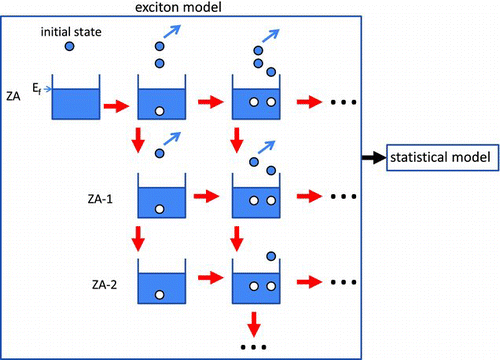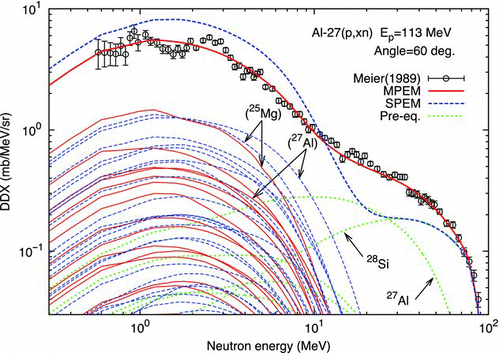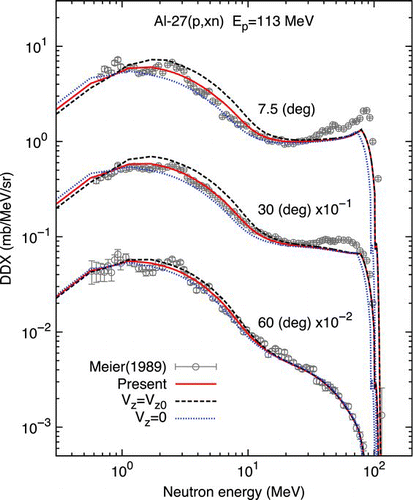Figures & data
Figure 1 Schematic view of multiparticle emission exciton model. Each box shows a potential well having fixed numbers of particles and holes indicated by closed circles above Fermi energy E f and open ones below it, respectively. Transitions of exciton states are indicated by right and down arrows between the same composite nuclei and the different ones, respectively. The right-up arrows mean particle emission. Details are given in the text

Figure 2 Comparison of the results of multi- and single-particle emission models. Double-differential cross sections (DDXs) for the 27Al(p,xn) reaction at 113 MeV. Solid lines show the DDXs calculated allowing multiparticle emission in the exciton model. The dotted lines show preequilibrium component by the exciton model from various composite nucleus. Dashed lines are the results obtained by restricting the number of emitted particle to one in the exciton model. Thin solid and dashed lines are evaporation spectra from statistical model calculations for MPEM and SPEM, respectively. Thick lines are the total DDXs. Thin lines were separated contributions from composite and compound nuclei. Nuclide-names are shown with and without the parentheses for evaporation and preequilibrium spectra, respectively

Figure 3 Comparison of DDX with different velocities of composite nuclei for the 27Al(p,xn) reaction at 113 MeV. The solid lines show the result with the present method. The dashed lines show the results with the assumption that the velocity is equal to the initial compound nucleus. The dotted lines are the results assuming that the velocities of composite nuclei are zero. The DDXs are multiplied by factors shown in the figure for visualization

Figure 4 DDX for the 27Al(p,xp) reaction at 61.7 MeV. The symbols indicate the experimental data by Bertrand and Peelle [Citation26]. The solid and dashed lines show the present results and evaluated data of JENDL/HE-2007 [Citation3], respectively. The DDXs are multiplied by factors shown in the figure for visualization
![Figure 4 DDX for the 27Al(p,xp) reaction at 61.7 MeV. The symbols indicate the experimental data by Bertrand and Peelle [Citation26]. The solid and dashed lines show the present results and evaluated data of JENDL/HE-2007 [Citation3], respectively. The DDXs are multiplied by factors shown in the figure for visualization](/cms/asset/6f3a1d6f-b472-4887-8ed5-b9def7b3b2bf/tnst_a_773168_o_f0004g.jpg)
Figure 5 DDX for the 27Al(p,xp) reaction at 200 MeV. The solid squares and open circles indicate the experimental data of Förtsch et al. [Citation27] and Avan et al. [Citation28], respectively. The solid and dashed lines show the present results and evaluated data of JENDL/HE-2007 [Citation3], respectively. The DDXs are multiplied by factors shown in the figure for visualization
![Figure 5 DDX for the 27Al(p,xp) reaction at 200 MeV. The solid squares and open circles indicate the experimental data of Förtsch et al. [Citation27] and Avan et al. [Citation28], respectively. The solid and dashed lines show the present results and evaluated data of JENDL/HE-2007 [Citation3], respectively. The DDXs are multiplied by factors shown in the figure for visualization](/cms/asset/e89635a1-aaff-4539-9a0c-986a4c176f07/tnst_a_773168_o_f0005g.jpg)
Figure 6 Energy spectra for the 27Al(p,xn) reaction. The solid and open squares show the experimental data of Kalend et al. [Citation29] at 90 MeV and of Svirin et al. [Citation30] at 22.4 MeV, respectively. The solid and dashed lines show the present results and evaluated data of JENDL/HE-2007 [Citation3], respectively. The spectra are multiplied by factors shown in the figure for visualization
![Figure 6 Energy spectra for the 27Al(p,xn) reaction. The solid and open squares show the experimental data of Kalend et al. [Citation29] at 90 MeV and of Svirin et al. [Citation30] at 22.4 MeV, respectively. The solid and dashed lines show the present results and evaluated data of JENDL/HE-2007 [Citation3], respectively. The spectra are multiplied by factors shown in the figure for visualization](/cms/asset/b904e7d8-745a-41a3-8a6e-9798128bc734/tnst_a_773168_o_f0006g.jpg)
Figure 7 DDXs for the 27Al(p,xn) reaction at 113 MeV. The symbols show the experimental data of Meier et al. [Citation24] The solid and dashed lines show the present results and evaluated data of JENDL/HE-2007 [Citation3], respectively. The DDXs are multiplied by factors shown in the figure for visualization
![Figure 7 DDXs for the 27Al(p,xn) reaction at 113 MeV. The symbols show the experimental data of Meier et al. [Citation24] The solid and dashed lines show the present results and evaluated data of JENDL/HE-2007 [Citation3], respectively. The DDXs are multiplied by factors shown in the figure for visualization](/cms/asset/1c57409e-3096-414c-ac02-fa287dcad61d/tnst_a_773168_o_f0007g.jpg)
Figure 8 DDXs for the 27Al(p,xn) reaction at 160.3 MeV. The symbols show the experimental data of Scobel et al. [Citation31] The solid and dashed lines show the present results and evaluated data of JENDL/HE-2007 [Citation3], respectively. The DDXs are multiplied by factors shown in the figure for visualization
![Figure 8 DDXs for the 27Al(p,xn) reaction at 160.3 MeV. The symbols show the experimental data of Scobel et al. [Citation31] The solid and dashed lines show the present results and evaluated data of JENDL/HE-2007 [Citation3], respectively. The DDXs are multiplied by factors shown in the figure for visualization](/cms/asset/18c10458-f090-4e87-bd90-37fd72752d30/tnst_a_773168_o_f0008g.jpg)
Figure 9 Proton energy spectra for the 27Al(n,xp) reaction for neutron energy from 28.5 to 62.7 MeV. Symbols show the experimental data of Benck et al. [Citation32] The solid and dashed lines show the present results and evaluated data of JENDL/HE-2007 [Citation3], respectively. The DDXs are multiplied by factors shown in the figure for visualization
![Figure 9 Proton energy spectra for the 27Al(n,xp) reaction for neutron energy from 28.5 to 62.7 MeV. Symbols show the experimental data of Benck et al. [Citation32] The solid and dashed lines show the present results and evaluated data of JENDL/HE-2007 [Citation3], respectively. The DDXs are multiplied by factors shown in the figure for visualization](/cms/asset/dc504437-b750-405d-8a71-b9e81c8391c1/tnst_a_773168_o_f0009g.jpg)
Figure 10 DDXs for the 27Al(n,xp) reaction at 62.7 MeV. Symbols show the experimental data of Benck et al. [Citation32] The solid and dashed lines show the present results and evaluated data of JENDL/HE-2007 [Citation3], respectively. The DDXs are multiplied by factors shown in the figure for visualization
![Figure 10 DDXs for the 27Al(n,xp) reaction at 62.7 MeV. Symbols show the experimental data of Benck et al. [Citation32] The solid and dashed lines show the present results and evaluated data of JENDL/HE-2007 [Citation3], respectively. The DDXs are multiplied by factors shown in the figure for visualization](/cms/asset/eeacf07d-8728-4bcc-9fbc-0bc3ca2e922e/tnst_a_773168_o_f0010g.jpg)